
by Lori Vande Krol | Feb 24, 2021 | Goals and Priorities, Meetings, Team Productivity, Technology, Time Management
The availability and ease of Zoom and other virtual technology has been one of the bright sides of this past year. Without it, we wouldn’t be able to see our colleagues and friends while working safely at home, continuing education opportunities would be minimal, grandparents may not see their grandchildren whether it be a few miles or thousands of miles away, and those sick in the hospital may not be able to see their family. One of my favorite things about virtual calls during Covid is being able to see full faces instead of masked ones. But, according to a recent study done by Stanford University professor Jeremy Bailenson, founding director of the Stanford Virtual Human Interaction Lab, being in these virtual meetings throughout your day can lead to exhaustion and may even increase stress.
The Mercury News summarizes the findings and suggestions from Professor Bailenson’s study, which addresses Zoom Fatigue from a technical and physical perspective. Here I share three additional ways we can minimize this stress and exhaustion from the standpoint of planning and productivity.
Be Intentional About Holding a Virtual Meeting
If you are the one initiating the meeting, determine whether the meeting is absolutely necessary and if so, if virtual is the most appropriate format. Would a phone call or conference call work just as well? Or is the topic something that could be handled quickly over email or chat?
If you have been invited to a virtual meeting or webinar, determine whether it is necessary for you to attend. What value will you receive? What will you add to the meeting? Be intentional about your choices.
Block “Meeting Days” and Add Breaks
If you have been intentional about the meetings you attend and it is still necessary for you to have several meetings a week, try to hold meetings on the same day as much as possible. While you may still have some Zoom fatigue at the end of that day, the benefits of one or two meeting-free days are great. You will be able to focus for longer periods of time with fewer interruptions and without the nagging feeling in the back of your mind that you need to remember to log in at a certain time. You’ll also save a little time on those days you don’t have to be “Zoom ready.”
When you schedule several meetings on the same day, be sure to leave a little time between them – I suggest 30 minutes. This allows a cushion in case the meeting runs over and also gives you time to review your notes, clarify and schedule next actions, and reset before the next meeting. Be sure to leave a few minutes to get up, move around, and refill your water.
Meeting Standards Don’t Change in a Virtual Setting
Standards and guidelines for a video meeting should be the same as an in-person meeting (except that sweatpants or leggings and a quiet pet in the background is perfectly acceptable). Someone should be responsible for the agenda, make sure that everyone has the materials they need ahead of time, and assign a leader to keep the meeting on track. Also, don’t end the meeting without full clarity regarding next actions and who is responsible. Learn the 5 key steps to an effective meeting.
I also recommend allowing a few minutes at the beginning of the meeting to check in with everyone. It’s been a tough year, and we could all use a little reassurance, support, and reminder that we’re all in this together.
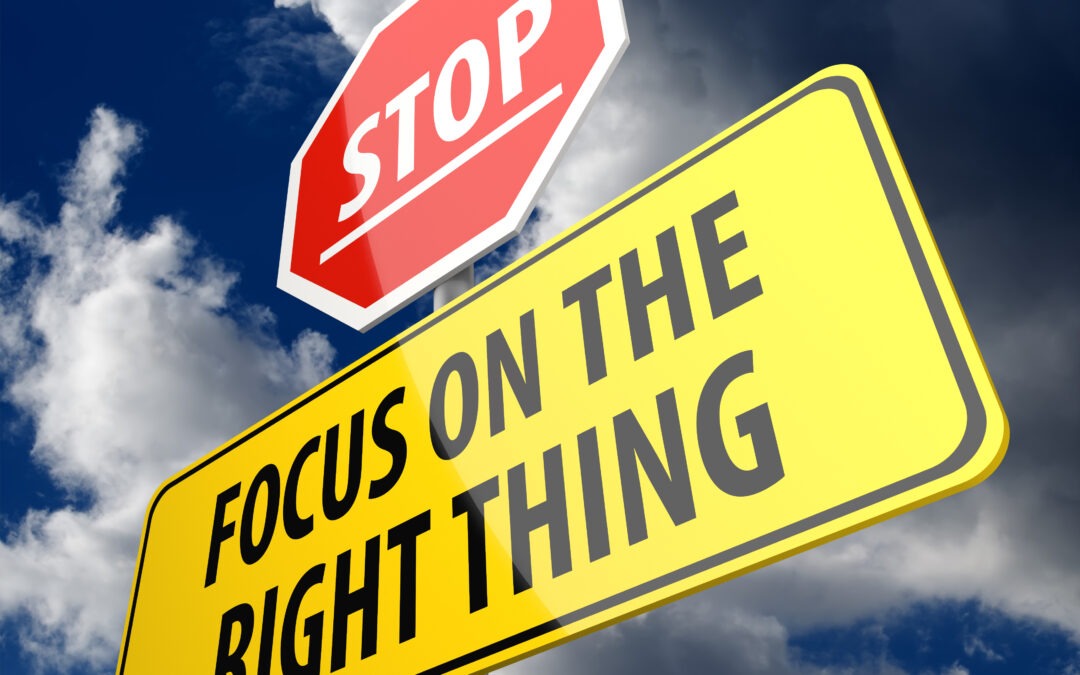
by Lori Vande Krol | Jan 14, 2021 | Goals and Priorities, Habits, Motivation, Task and Project Management, Time Management
If you are like most creative, driven entrepreneurs and professionals, you have a lot of big goals, fun projects, and life-changing ideas on your plate – not to mention the other day-to-day tasks and activities that take up your time. Without a good process for analyzing, prioritizing, and planning, you can become overwhelmed and frustrated that yet another day – or week – goes by without measurable progress. Here I share 3 ways to address this overwhelm so you can reach your big goals quickly and with more focus and less stress, allowing you to share your passions with the world and have fun at the same time.
Success = Skill + Passion + Hard Work
Paul Torrance, Distinguished Professor, researcher, and developer of the Torrance Tests of Creative Thinking, conducted a 40-year longitudinal study of creative individuals. Based on the results of his study, Torrance developed the Manifesto for Children to guide them as they grow and struggle to maintain their creativity and use their strengths to create careers. While Torrance intended his manifesto for children, I think the guidance applies to adults as well.
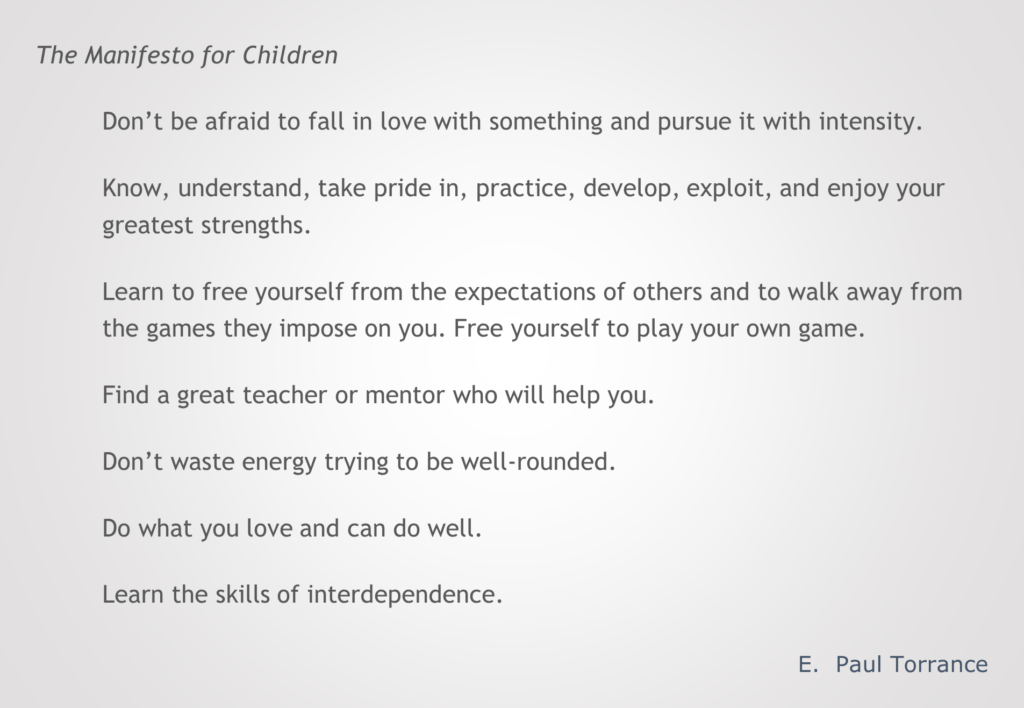
Many of us learn these important ideas later in life, or maybe not at all. Torrance hoped to help improve a creative individuals’ chance of success and life fulfillment with his study and manifesto.
Similarly, you will be most successful and be able to help others more when you focus your time and energy on those things you are good at and passionate about. Big goals take hard work and if you don’t have the knowledge and excitement, you will be much less likely to put in the time and effort required. To narrow down the activities you should be spending your time on, draw the following grid on a piece of paper, and divide your ideas, goals, and activities into these categories:
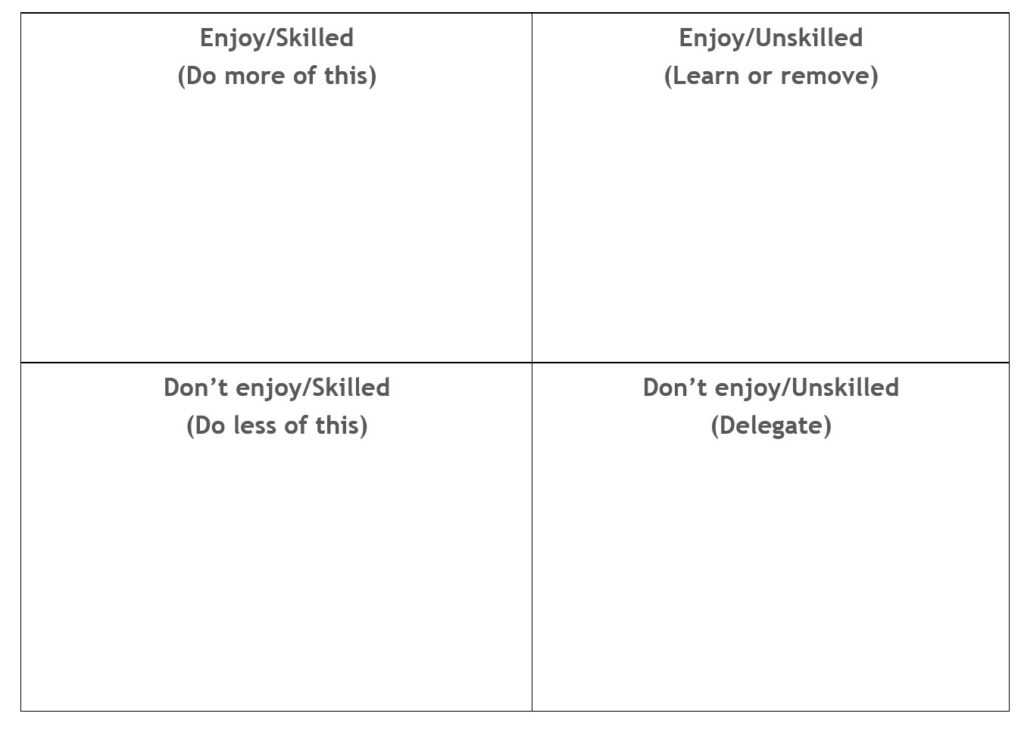
You will want to spend the most time on activities and goals from the top-left “Enjoy/Skilled” quadrant and develop educational or learning goals from the top-right “Enjoy/Unskilled” quadrant. Or, if these activities don’t serve your greater goals, consider removing them. Look at delegating tasks in the bottom half of the grid – those you don’t enjoy – or if possible, remove them. Deleting tasks that don’t serve your greater purpose and goals will open the door for new opportunities.
Determine What To Start, Stop, or Continue Doing
A second exercise that can help you focus on your passions and priorities is the “Start/Stop/Continue” exercise. Write these three words on the top of a piece of paper and list all of those things you would like to start doing, stop doing, and continue doing. If you are a visual person, you might use mind-mapping as a way to brainstorm activities or tasks for each category.
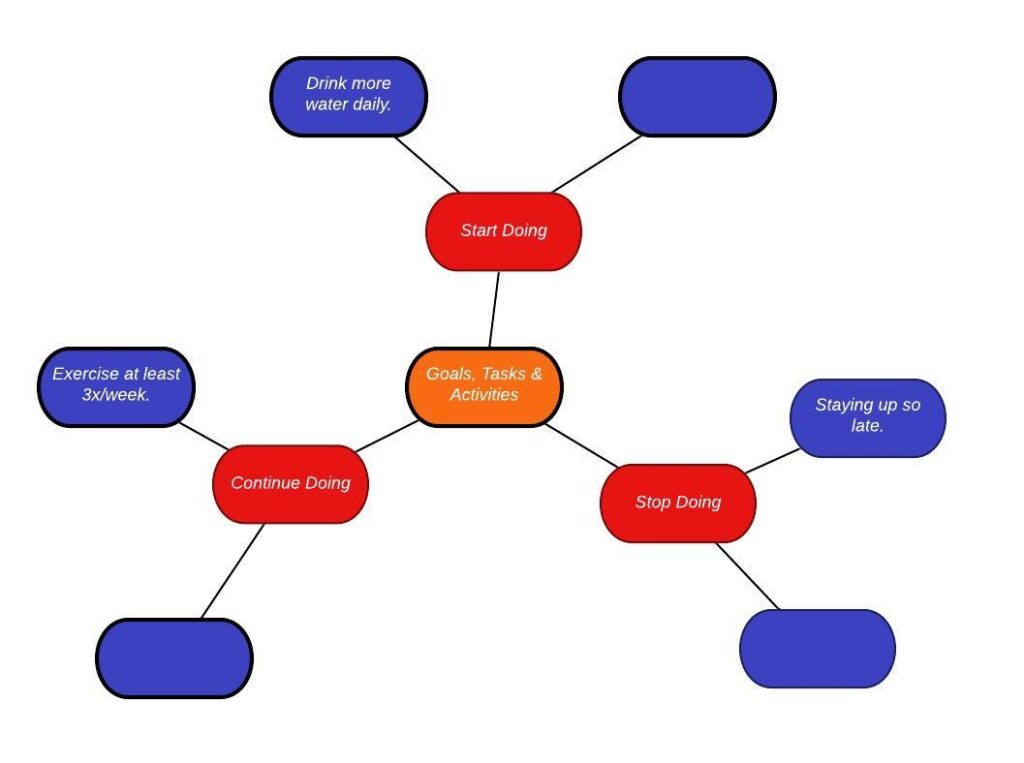
Be realistic when considering your time and energy over the time period considered. This is a great exercise for habit-related activities and goals. For example, in order to have the energy and focus for my big goals, I would like to start drinking more water daily, stop staying up so late, and continue exercising at least 3 days per week.
Find Support and Accountability to Reach Your Goals
Being an entrepreneur, business owner, or leader can be lonely. You want to do great things but may not have someone that understands and shares your passion and drive. Without someone there to communicate your struggles and help get through roadblocks, there may be a loss of momentum or halted progress on your goals. It’s also important to be able to share your excitement when reaching milestones. E. Paul Torrance felt strongly enough about this to include two related items in his Manifesto for Children: “Find a great teacher or mentor who will help you.” and “Learn the skills of interdependence.”
Following are a few different ways you can find this support and assistance:
- An accountability partner. This may be a family member, friend, or colleague, as long as they share your drive and passion and provide the support and encouragement you need through the good and challenging times.
- A mastermind group. The advantage of a formal mastermind group is you have a team of people with different backgrounds, experiences, and skillsets as you work to set and reach your goals. For the best chance of success, I would recommend a paid group with an experienced leader/host.
- A business, life, or productivity coach. Sometimes it makes the most sense to hire a coach to help you get clear on your passions, strengths, and goals and then to help you develop the plan to reach those goals. This person should provide motivation and accountability, be a sounding board as you work through challenges and offer solutions to keep you moving, and be your greatest cheerleader when things go well.
The world needs your big ideas – your book, your product, your new business, your knowledge, your energy, your talent. What will you do to ensure you prioritize, focus, and take action so you can reach your biggest goals?
More blogs related to Priorities, Goal-Setting, and Planning:
Get Unstuck with a Simple Project Plan
Create Your Top 10, and Bottom 10, List
The Superman: Goal Achieved
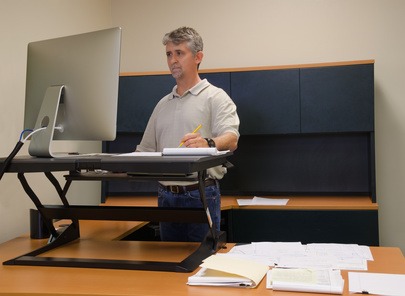
by Lori Vande Krol | Jul 13, 2020 | Tools
Maybe you’ve wondered if the fancy stand-up desk your company purchased for your colleague is a waste of money and just the latest “shiny object.” Or perhaps you’ve considered one for your home office but aren’t really sure if the claims of increased health and productivity are true. A study from Texas A&M University found that employees who used sit-stand desks were 46% more productive than those at traditional desks. In addition, numerous research studies show that too much sitting can cause a decrease in overall health and productivity. Apparently this latest “shiny object” is here to stay. A team at ConsumersAdvocate.org recently researched the most popular standing desk models and found which ones lead the market based on features, affordability, and customer experience. In addition, they offer some helpful tips when looking for standing desks, outlining the important features, warranty options, and how to properly use them.
Tips for Choosing a Desk
- Test the theory. See if you like standing while you work. Use your kitchen counter, your washing machine, or any other surface that’s ergonomically correct for your body. Chances are, you may even have a friend who uses a standing desk; see if you can use it for a couple hours before spending the money to invest in your own.
- Check out maximum height. Desks should accommodate a wide variety of body types, so make sure they can reach at least 48 inches, with a 20-inch sit-to-stand range, which is ergonomically okay for anyone up to 6 feet 7 inches.
- Look for great warranties. A standing desk can be a major expense, especially for companies looking to furnish their offices — one desk can cost anywhere from a few hundred dollars up to $4,000. For those more expensive desks, be sure it offers a frame and electronics warranty of at least five years.
- Make sure the desks are easy to assemble. How will the desk arrive? In how many boxes? How quick and easy will it be to assemble?
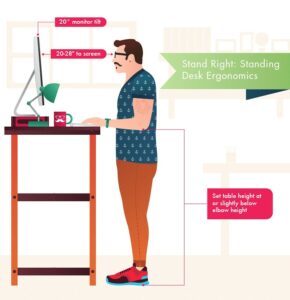 Using Your New Desk
Using Your New Desk
Once you’ve chosen and assembled your standing desk, it’s important you are using it properly. Did you know there is a right way and a wrong way to use a standing desk? Ergonomics are key. The top of your monitor should be at or just below eye level (make sure your head isn’t angled down), and your eyes should be 20 to 28 inches from the screen. Keep your upper arms close to your body, your wrists straight, and your hands at or below wrist level. The table height of a standing desk should be at or slightly below elbow height — basically make a 90-degree angle with your elbow. Your head, neck, and torso should be in line, and your keyboard and mouse should be at the same level. Got that? If not, here’s a graphic that sums it all up, courtesy of CustomMade.
Remember to Move
There are downsides to sitting too long and also to standing too long. Purchasing a standing desk won’t solve these problems unless you remember to change your posture. From the words of Dr. Lucas Carr, an expert in physical activity promotion and sedentary behaviors, “Our bodies were designed to move periodically throughout the day. I advise people to stand up, stretch, and take a short walk (if possible) if you feel you’ve been sitting for too long.”
If you would like to learn more about which standing desks ConsumersAdvocate.org chose as their top picks check out the rest of their guide here.

by Lori Vande Krol | Mar 24, 2020 | Email, Goals and Priorities, Organization, Task and Project Management, Technology, Time Management, Tools
The past several weeks with the coronavirus pandemic have been unprecedented. We are in an environment of fear, stress, uneasiness, and unknowns. While it will take time for us to work through these emotions, it is important that we also try to continue as normal in ways that we can control. Productivity expert Barbara Hemphill said, “Control the things you can, so you can cope with the things you can’t.” I think this is true now more than ever.
19 Productive Actions You Can Control
One byproduct of social distancing is that many of us have found ourselves with unexpected time on our hands – closings, canceled events and appointments, reduction in travel time on planes, trains, and cars, and for some, an unfortunate reduction in customers or client work. Why not utilize this time for tasks or projects you have been putting off or just haven’t had the time to address? Take some control by working on things that will strengthen and grow your business, your career, and/or yourself, and create a solid base for “after the virus.”
Below I share a list of 19 productive actions you can take now, along with tips, resources, and recommended tools to assist with the task. Don’t be overwhelmed by the length of the list. Instead, choose a few of the highest priority items for you and/or your business and focus on taking action on those first.
At the end of the article, I provide a free download that will allow you to more easily prioritize each item and track your progress.
Disclaimer: Life Made Simple sometimes partners or affiliates with companies providing products, applications, or services that we feel would benefit our clients. In these cases, we may receive a small commission on sales through our affiliate links.
Organize Your Office Space and Information
1. Organize your office space
Whether you have a room devoted to work or space within another room, a clear, organized area can help improve focus and productivity. Clear off your floor, desk, and other surface areas. Toss, recycle, shred, or donate any unneeded items. Leave out only those items that add to your productivity, peace, or joy.
2. Clean out and organize your paper files
Divide your files into action (items you are working on now) and reference (items you are keeping for tax/legal reasons or future reference). Label files alphabetically (e.g. client files) or topically. If you have more than one file drawer full of paper, consider numerical labels and an online inventory of your paper files using the Paper Tiger filing system.
3. Set up a daily and/or monthly action file system
An action file system such as this one by Smead allows you to file papers or cards by day and/or month as reminders to complete a task or to be easy accessible when you need them. Keep the file system in a desktop file
allows you to file papers or cards by day and/or month as reminders to complete a task or to be easy accessible when you need them. Keep the file system in a desktop file along with a few hanging files to hold quick reference papers.
along with a few hanging files to hold quick reference papers.
4. Declutter and organize your digital files
Depending on your current structure and content, decluttering and organizing digital files can mean something different for everyone. Start with this checklist of things to think about when attacking your digital world and then develop your unique plan.
5. Set up your email for productivity
Like digital file management, email management can differ depending on the application you use (e.g. Outlook or Gmail), how much email you receive daily, and whether you use your email app for other productivity tasks such as calendar, tasks, and contacts. Check out this past blog post to help you get started with The Only 5 Email Folders You Really Need.
6. Go paperless
Moving towards a paperless environment requires a good scanner. My favorite scanner for moving those piles of paper, notes, and business cards to digital form is the Fujitsu ScanSnap. It is the most expensive tool of all of the resources mentioned here, but well worth the cost if you work with a lot of paper, want to be more digital, and/or often work remotely.
7. Manage your contacts
Whether this means scanning or entering business card information, cleaning out old contacts and updating current ones (I use the Duplicate Contacts app for Android and Apple phones – there are many others!), or setting up a full-blown CRM (customer relationship management) system, contact management is a great way to spend some unexpected downtime.
Get Clear on Your Goals
8. Determine your rocks (what is most important)
If it has been a while since you really stepped back to evaluate what is important to you in business and life, this is a great time to get re-centered and focused on what matters most. I am happy to share an exercise I use with individuals and groups for this reason.
9. Develop your 2020 goals
Once you know your “rocks,” you can work to develop your goals for the remainder of the year. I am confident life will get back to normal and when it does, what will you focus on for the remainder of the year? It’s okay if your goals aren’t perfect right now. Just get something on paper and then reevaluate once the pandemic has passed.
Analyze and Manage Your Time
10. Analyze your time management habits
When it comes to time management, have you ever wondered where you excel? And where you could improve? Spend some time looking at your strengths and weaknesses and make a plan for continuous improvement. If you’d like help with this reflection and/or putting systems in place to better manage your time, please contact me. I’d love to help!
11. Start using a daily time management tool
Now may also be the perfect time to review a few different time management tools to see what might work best once we get back to our hectic lives. Of course, my favorite is the ProAction Planner. [Update: Check out this article from Well + Good listing the top planners for 2025.]
Practice Risk Management
12. Back up your files
You have many options for backing up files, photos, email, and other digital information:
13. Evaluate your financial position
For businesses, utilize your current financial tool to review your actual results versus goals to date in 2020. How will this downtime impact your goals, if at all? If you are not using a financial tool, consider implementing one. Quickbooks, Freshbooks, and Xero are popular options. (Before introducing a tool such as these, be sure to do a technology needs assessment to ensure you are choosing the right tool for your needs. Last month’s blog shares a list of things to consider when analyzing a new or improved technology tool.)
Individuals should also review the impact of the pandemic on their financial position and develop a resulting budget and plan for the rest of the year.
Work on Yourself
14. Learn or fine-tune a skill
Skillshare, is a great resource for videos and training resources for a variety of skills. And, the first 2 months are free! A quick search on YouTube or Google will provide many more options.
15. Read a book
While I’m sure you have your own list of “must-read books,” a few non-fiction books I recommend (depending on your need and interests) are:
Building a StoryBrand: Clarify Your Message So Customers Will Listen
Atomic Habits: An Easy & Proven Way to Build Good Habits & Break Bad Ones
Unstoppable: A 90-Day Plan to Biohack Your Mind and Body for Success
I have a long list of recommended fiction books as well. Let me know if you are interested, or share your favorites in the comments below.
16. Get/stay healthy (exercise, meditation, healthy eating)
Getting and/or staying healthy when stuck at home takes a little bit of work. Since my normal workout location is closed, I joined an on-demand site with videos of the classes I normally take and purchased an inexpensive weight set on Amazon.com. Many workout locations and online exercise sites are providing free challenges, workouts, and videos. In addition, you can find several meditation, yoga, and recipe or meal apps in your phone’s app store.
17. Spring clean your home
Okay, I know this isn’t really “working on yourself” but It is a great way to feel better about yourself and your environment, and a clean, clutter-free home can help you feel more productive in your home office. Here are a few Spring Cleaning Checklists to track your progress. I chose to use the third as I felt it was the most inclusive and I liked that it gave me space to add my own tasks.
The Happier Homemaker
Freebie Finding Mom
Imperfect Homemaking
Give Back
18. Send cards, texts, or emails
Make someone feel a little less lonely or just make someone smile with a note of thanks or encouragement.
19. Help others
Giving can be financial, but doesn’t have to be. Drop off needed supplies or other physical donations, safely volunteer your time if you are healthy and able, or donate blood. You might also share your expertise or knowledge to help others in areas of need during this time, as is my hope with this blog. Buzzfeed and PBS share lists of other ways to help during the pandemic. And this article from Bankrate provides a unique idea – giving back utilizing your credit card rewards points.
Free Downloadable Checklist
I realize this is a long list! Not every item will apply or be important to every reader. In order to prioritize and track your unique action list, I am providing a free, downloadable checklist below. Be sure to refer back to this blog for the supporting resource links.
If you are in need of assistance, coaching, or support related to any of these tasks, please reach out via my contact page or by scheduling your free 30 minute productivity assessment. All of my work can be done virtually via phone or video call.
I wish all of you health, safety, love, and peace over the coming weeks and months. Spend time with family, call your friends, give back, focus on you, and control what you can.

by Lori Vande Krol | Feb 17, 2020 | Task and Project Management, Team Productivity, Technology
Unless you completely avoid politics and social media, you have no doubt heard about the “caucus chaos” that recently occurred right outside my door in Iowa. Much of the media has blamed the chaos on a new smartphone app the Iowa Democratic Party implemented to help get results more quickly. Because I have a large interest in the successful selection and implementation of technology, I thought I’d dig into it a bit further. What happened in Iowa is just one very publicized example of what happens daily in companies and organizations that do not take the time to properly analyze their vision and needs when choosing a new technology tool, or to carefully plan for a successful implementation of the chosen system. How could this have been avoided?
What Went Wrong with the Iowa Caucus?
It is true that much of the cause for reporting delays and questions about count accuracy was due to a “coding error” in the Shadow smartphone application that was used by the Iowa Democratic Party (IDP) to report caucus voting results. The error resulted in only partial results being reported. But if you look just a little deeper, there were more underlying issues that can’t be blamed solely on the creator of the application.
Following are additional factors leading to the issues with the Iowa Caucus:
- State campaign finance records show the IDP paid Shadow, the tech company that created the app used in Iowa, more than $60,000 for “website development” towards the end of 2019. Shadow (or what I’ve also seen called the Iowa Reporter App) was a new app, reported to be just 5 months old, and created specifically for reporting of caucus results. This is not enough time to have been developed and fully tested before being rolled out for such a large and public endeavor.
- Once the IDP had the app, there was not enough time for users to learn and test it themselves. In fact, some users weren’t even able to get past the log-in screen.
- This year, a new set of reporting requirements was put in place by the Democratic National Committee. Historically, precincts would only announce the outcome in terms of state delegate equivalents (S.D.E.s). In 2020, precincts were required to report three numbers per candidate: (1) raw vote totals, (the initial alignment), (2) the totals after the shifts of participants from non-viable candidates (the second alignment) and (3) the estimated delegate count for each candidate. While this may be confusing for those not involved with caucus procedure, it isn’t difficult to reason that this increase in requirements, along with the use of a new application, and short time frame for development, training and testing, was the start of “the perfect storm.”
- In addition to the Shadow app, it was reported that there were training issues with other programs needed for efficient reporting of results, including Google Sheets, and problems with 2-factor authorization needed to access those programs.
- The back-up process for reporting results when the app did not work was to call headquarters and manually report results (which is the way it had been done in past years). But, there were not enough lines and/or people to answer these calls and volunteers were left waiting for hours. It was quite obvious the back-up plan hadn’t been fully thought through.
It is my guess that there were more issues involved in the selection and implementation of caucus reporting systems and processes this year. Iowa Democratic Party Chairman, Troy Price, has called for an independent forensic review of the decisions and processes (or lack of processes) that led to the failure. I look forward to learning more from that review.
2020 Iowa Caucus Consequences
What we do know is that there has been some pretty large consequences of the lack of proper analysis, testing, and implementation.
- Chairman Price has resigned as chair of the party after 2.5 years of service, effective as soon as a replacement is elected.
- The Nevada Democratic Party, who had planned to use Shadow, has now dropped the vendor.
- The Democratic National Committee Chair, Tom Perez, along with the Bernie Sanders campaign, have asked for a “recanvassing” check of votes.
- Thousands of extra volunteer and paid hours were needed to report the initial results and will be needed to assist with the recanvassing as well as the independent forensic review.
- The negative PR for the Iowa Democratic Party and the state of Iowa will likely result in Iowa losing its status as the first caucus state in the country, with a large impact to hotels, restaurants and other local vendors that benefited from the event. It is not unreasonable to assume this misstep has costed the IDP and the State of Iowa hundreds of thousands of dollars.
How the Caucus Chaos Could Have Been Prevented

The chaos that occurred in Iowa could have been fairly easily prevented. Following are the key components of successful technology assessment and implementation, and what may have been missing from the Iowa Caucus process:
Understand Your Need and Create a Vision for Success
What is driving the desire or need for the new system or tool? Are you solving an issue, creating efficiencies, or enhancing a process in another way? What will success look like? What will you be able to do that you cannot do now?
What was missing? While we won’t know for sure until after the independent review, I have to wonder if the IDP did what I see many other companies do…they go for the newest shiny object without truly analyzing the need and how the tool might fulfill it. Was it necessary to change the current system for caucus counting and reporting? What was the specific issue that needed to be addressed? If there was a challenge in the current process, or the IDP wanted to save time and create efficiencies by using an automated app, was a vision defined? How did they see a new tool working and what would success look like? They could then choose a tool to best fit that vision for success. Perhaps the IDP did spend some time on this component and was clear in their need and vision but faltered in a later step.
Implement a Needs Analysis
A formal Needs Analysis takes the component above – understanding need and vision – several steps further in that it provides a process for decision makers to gather information needed to select the optimal technology. The Needs Analysis will address:
- resources available and new resources needed to implement and maintain the tool, including human and financial resources, and timeline;
- any obstacles that could get in the way of implementation or maintenance of the tools;
- level of comfort with technology, leading to a better understanding of training needs;
- features needed, which can be gathered in a format such as “must have”, “nice to have”, and “not needed.”
What was missing? Did the IDP take the time to evaluate all of these steps prior to asking Shadow to develop the app for them? They may have been clear on their budget and the needed features, but it is clear that not enough time was spent discussing obstacles that could prevent effective implementation (such as the app not working when it is needed most!), training needs due to many users not having a high level of comfort with technology, and the impact of an unreasonable timeline for development, testing, and training. This could have all been addressed with an appropriate Needs Analysis.
Match the Need with the Technology
Once the Needs Analysis has been completed, it becomes much easier to match the appropriate technology tool with the need. There are many great resources to find and evaluate applications but what is most important is to find the tool that best matches the results of the Needs Analysis and to evaluate the strength, security, and longevity of the application’s creator and/or owner.
What was missing? Without the appropriate Needs Analysis, it was impossible for the IDP to know whether they were choosing the most optimal system. Based on a February 4, 2020 article from The Atlantic, there is evidence that this was a situation in which leaders in the IDP knew some of the leaders in Shadow’s company and that appeared to be enough to move forward with their application.
Develop the Project Plan
Once the optimal technology is chosen, it is time to develop a plan for successful implementation. There is too much involved with project planning to cover here (refer to Get Unstuck With a Simple Project Plan for project planning tips), but the importance of creating and following a technology implementation plan cannot be stressed enough.
What was missing? What wasn’t missing? I believe that due to the tight time frame involved, the IDP had no time to develop or carry out a successful project plan. Just a few of the pieces missing were: (1) time for testing the application, (2) training of all users, and (3) creation of backup plans for multiple situations.
Take a Holistic View of Technology
A holistic view of technology means looking at all of the systems currently used by an organization and determining how new technology will coordinate and compliment those systems. This is important for an efficient implementation of the new technology as well as continued effective use and maintenance.
What was missing? While I am not aware of all of the systems utilized by the IDP, one main obstacle that was not addressed was how to coordinate the use of the new application with those precincts that desired or needed to continue to use the old, manual method of reporting. It has been reported that the IDP assumed all volunteers would download the app with no issues, even though some did not receive instructions to do so until 2 days before the caucus. Staffing and technology needed to take the manual calls was not sufficient. Additionally, there was the issue with 2-factor authorization that was discussed earlier. Cell phones were not allowed in counting rooms, but 2-factor authorization within the technology required volunteers to have their cell phones to receive the security code. Understanding how the technology would need to coordinate with the use of cell phones was vital here.
What Have We Learned from the Iowa Caucus Chaos?
While the Iowa Caucus gaffe was certainly unfortunate and impactful, how many can say they have never been involved with an organization that has not made a similar mistake – rushing through decisions, not completing a thorough needs analysis, or not developing and following a project plan? In my work as a productivity consultant, I often find during new client discovery sessions that some of their productivity challenges are caused by the mistakes made in technology selection and/or implementation. Organizations ranging from Fortune 500 corporations to very small businesses struggle every day with the results of poor planning and decision-making resulting in thousands of hours and millions of dollars lost and frustrated management and employees. Additional time and money are then spent to clean up the mess and redo the process the right way.
Hopefully some good can come from the Iowa Democratic Party’s mistake, that is a larger awareness of the importance of following the steps for successful technology implementation. While it will take more time and effort upfront, we have learned that the consequences of not doing so can be much greater.







 Using Your New Desk
Using Your New Desk
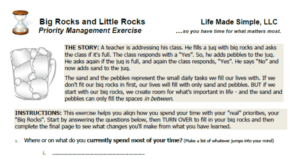
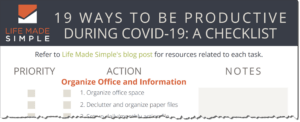


Recent Comments